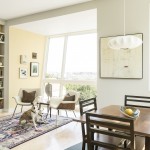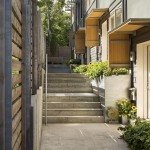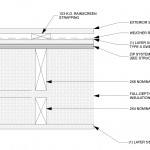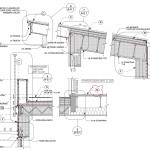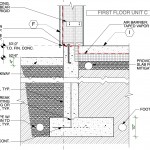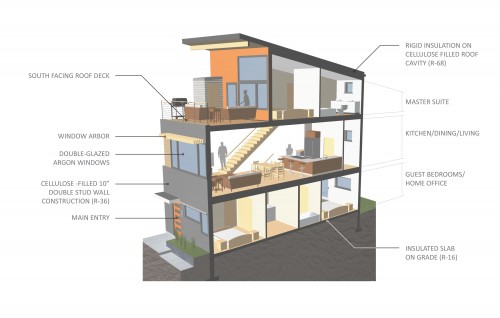Harborview Townhouses
Project Name
Townhouses are a rare commodity in Portland, but there is great demand for this style of urban living style that lets you have both a private entrance and a pocket green backyard.
We organized the units along a side path that gently rises from the street, with each unit’s doorway tucked along the common path. On the opposite face of the building we crafted a series of private terraces at grade level. The neighboring buildings sit close together, so we raised the main living spaces up to the second level for better light, views and privacy. The master suites were situated on the third floor with 5 of the 7 units afforded spectacular exterior deck space. Although set back from the street due to site constraints, the street-facing elevation greets guests and tenants with two cantilevered and leaning bay windows.
The building is wrapped in a calm skin of durable grey fiber-cement with highlights of galvanized metal and raw cedar – nods to the practical character of the nearby working waterfront. This project highlights the possibilities for increasing density in an urban environment while maintaining a contemporary, locally-derived character.
The project was built for only $150 / SF, a remarkable cost for this level of sustainability and design.
The project was designed for an estimated total energy use of EUI 25, and a heating consumption of 15 kBTU / SF / year Net Floor Area.
Architecture or A/E Firm Name
Architect
Team
Consultants
Location
Client
General Contractor
MEASURE 1: DESIGN & INNOVATION
- The client purchased a narrow, seemingly unbuildable ½-acre lot within walking distance to downtown Portland, Maine. The design brief was to build modern, beautiful 7-unit townhomes on this constrained urban lot with 11 abutters.
- This project highlights the possibilities for increasing density in an urban environment while maintaining a contemporary, locally-derived character.
-
Design brief was to build a modern, beautiful 7-unit townhome building on a constrained urban lot with 11 abutters. Total building square footage = 11,841.
MEASURE 2: REGIONAL COMMUNITY DESIGN
- The design takes material cues from the nearby working waterfront by using durable fiber cement panels, galvanized metal connectors, cable railings, and muted colors.
MEASURE 3: LAND USE & SITE ECOLOGY
- All landscape design by Soren Deniord Design Studio, using native plantings, low-water use and easy maintenance.
- Through locating project in a tight urban lot, we took advantage of proximity to amenities, transportation and infrastructure – an alternative to a suburban, car-dependent development.
-
Each unit has dedicated back yard separated from neighbors by beautiful Cedar privacy fencing. Galvanized metal planters between building and circulation path creates both privacy and gardening opportunities for urban dwellers. Sloping site creates a stepped rhythm when moving between units.
MEASURE 4: BIOCLIMATIC DESIGN
- It uses cold climate air-source heat pumps with variable speed compressors for extremely efficient heating and cooling, and high efficiency energy recovery ventilators for abundant fresh air and removal of pollutants.
- Main living spaces placed on second level to take advantage of light, views, air and privacy.
MEASURE 5: LIGHT & AIR
MEASURE 6: WATER CYCLE
- Low-flow plumbing fixtures throughout.
- Low-water use and maintenance landscaping.
MEASURE 7: ENERGY FLOWS & ENERGY FUTURE
- Extremely high performance building shell, with thick, double-stud, well insulated walls, floors and roofs.
- Comfortable, warm units due to the high quality insulation and construction methods.
- We expect the building to use 50% less energy than a typical building of this type, allowing heating costs to stay under $750 per year to ensure lifetime affordability. The project meets the Architecture 2030 guidelines for carbon emission limits.
MEASURE 8: MATERIALS & CONSTRUCTION
- The envelope of the building is a wood-framed, completely thermally-broken double stud wall construction – which was panelized in a factory and trucked to the site to be erected in a very short time frame.
- Sun shading was carefully optimized to prevent summer overheating on the extensive glazing.
- Local Maine wood framing throughout, with eastern white cedar accent panels and trim.
- No added formaldehyde in any wood products.
- No VOC paints and finishes throughout the project.
- This building is highly insulated with thermally-broken details (R-68 roof with exterior rigid insulation; R-36 wall with double stud construction; R-16 slab with edges thermally “broken” from exterior).
- It uses cold climate air-source heat pumps for heating and cooling, and energy recovery ventilators for abundant fresh air. Windows are Low-E, double-glazed and argon-filled for efficiency and comfort.
- Exterior materials of fiber-cement, galvanized metal and Eastern White Cedar were chosen as much for durability as for aethetics.
- Low or no VOC paints, adhesives and sealants.
- All appliances are EnergyStar rated. All plumbing fixtures are low-flow or dual flush.
- The project meets the Architecture 2030 guidelines for carbon emission limits.
MEASURE 9: LONG TERM FLEXIBILITY AND ADAPTABILITY
Entire main level is designed to be barrier-free.




